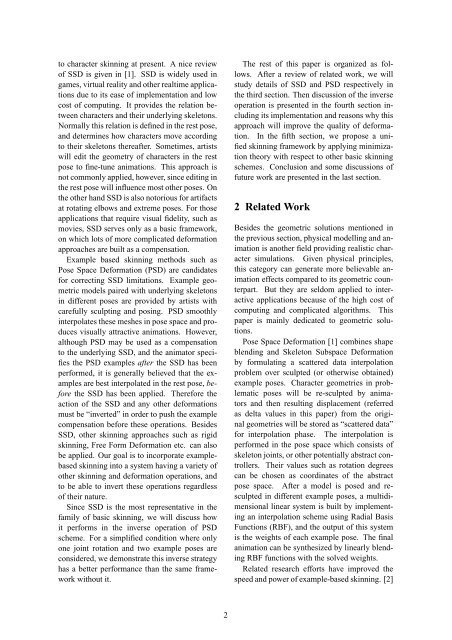A Powell Optimization Approach for Example-Based ... - JP Lewis
A Powell Optimization Approach for Example-Based ... - JP Lewis
A Powell Optimization Approach for Example-Based ... - JP Lewis
Create successful ePaper yourself
Turn your PDF publications into a flip-book with our unique Google optimized e-Paper software.
to character skinning at present. A nice reviewof SSD is given in [1]. SSD is widely used ingames, virtual reality and other realtime applicationsdue to its ease of implementation and lowcost of computing. It provides the relation betweencharacters and their underlying skeletons.Normally this relation is defined in the rest pose,and determines how characters move accordingto their skeletons thereafter. Sometimes, artistswill edit the geometry of characters in the restpose to fine-tune animations. This approach isnot commonly applied, however, since editing inthe rest pose will influence most other poses. Onthe other hand SSD is also notorious <strong>for</strong> artifactsat rotating elbows and extreme poses. For thoseapplications that require visual fidelity, such asmovies, SSD serves only as a basic framework,on which lots of more complicated de<strong>for</strong>mationapproaches are built as a compensation.<strong>Example</strong> based skinning methods such asPose Space De<strong>for</strong>mation (PSD) are candidates<strong>for</strong> correcting SSD limitations. <strong>Example</strong> geometricmodels paired with underlying skeletonsin different poses are provided by artists withcarefully sculpting and posing. PSD smoothlyinterpolates these meshes in pose space and producesvisually attractive animations. However,although PSD may be used as a compensationto the underlying SSD, and the animator specifiesthe PSD examples after the SSD has beenper<strong>for</strong>med, it is generally believed that the examplesare best interpolated in the rest pose, be<strong>for</strong>ethe SSD has been applied. There<strong>for</strong>e theaction of the SSD and any other de<strong>for</strong>mationsmust be “inverted” in order to push the examplecompensation be<strong>for</strong>e these operations. BesidesSSD, other skinning approaches such as rigidskinning, Free Form De<strong>for</strong>mation etc. can alsobe applied. Our goal is to incorporate examplebasedskinning into a system having a variety ofother skinning and de<strong>for</strong>mation operations, andto be able to invert these operations regardlessof their nature.Since SSD is the most representative in thefamily of basic skinning, we will discuss howit per<strong>for</strong>ms in the inverse operation of PSDscheme. For a simplified condition where onlyone joint rotation and two example poses areconsidered, we demonstrate this inverse strategyhas a better per<strong>for</strong>mance than the same frameworkwithout it.The rest of this paper is organized as follows.After a review of related work, we willstudy details of SSD and PSD respectively inthe third section. Then discussion of the inverseoperation is presented in the fourth section includingits implementation and reasons why thisapproach will improve the quality of de<strong>for</strong>mation.In the fifth section, we propose a unifiedskinning framework by applying minimizationtheory with respect to other basic skinningschemes. Conclusion and some discussions offuture work are presented in the last section.2 Related WorkBesides the geometric solutions mentioned inthe previous section, physical modelling and animationis another field providing realistic charactersimulations. Given physical principles,this category can generate more believable animationeffects compared to its geometric counterpart.But they are seldom applied to interactiveapplications because of the high cost ofcomputing and complicated algorithms. Thispaper is mainly dedicated to geometric solutions.Pose Space De<strong>for</strong>mation [1] combines shapeblending and Skeleton Subspace De<strong>for</strong>mationby <strong>for</strong>mulating a scattered data interpolationproblem over sculpted (or otherwise obtained)example poses. Character geometries in problematicposes will be re-sculpted by animatorsand then resulting displacement (referredas delta values in this paper) from the originalgeometries will be stored as “scattered data”<strong>for</strong> interpolation phase. The interpolation isper<strong>for</strong>med in the pose space which consists ofskeleton joints, or other potentially abstract controllers.Their values such as rotation degreescan be chosen as coordinates of the abstractpose space. After a model is posed and resculptedin different example poses, a multidimensionallinear system is built by implementingan interpolation scheme using Radial BasisFunctions (RBF), and the output of this systemis the weights of each example pose. The finalanimation can be synthesized by linearly blendingRBF functions with the solved weights.Related research ef<strong>for</strong>ts have improved thespeed and power of example-based skinning. [2]2







